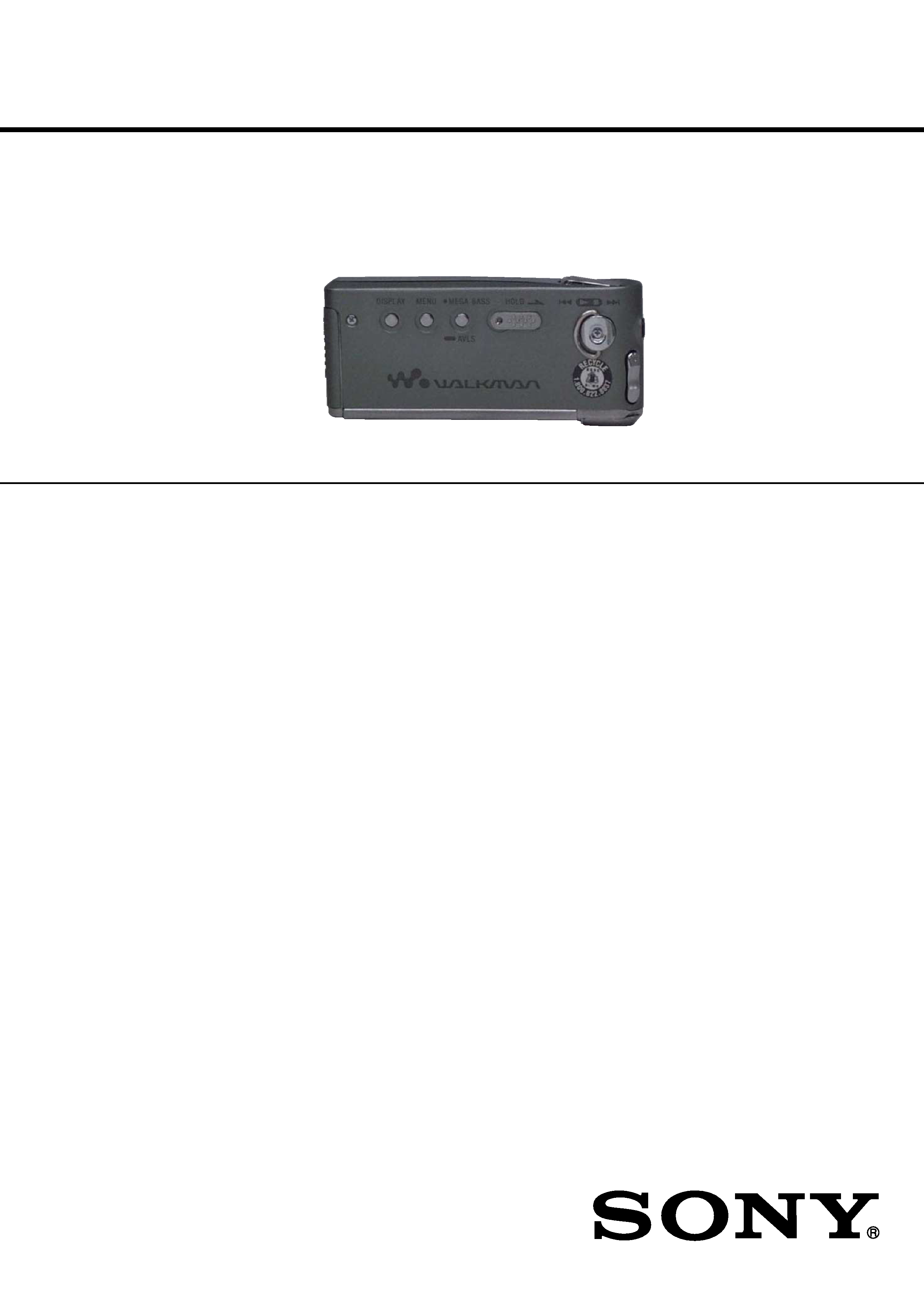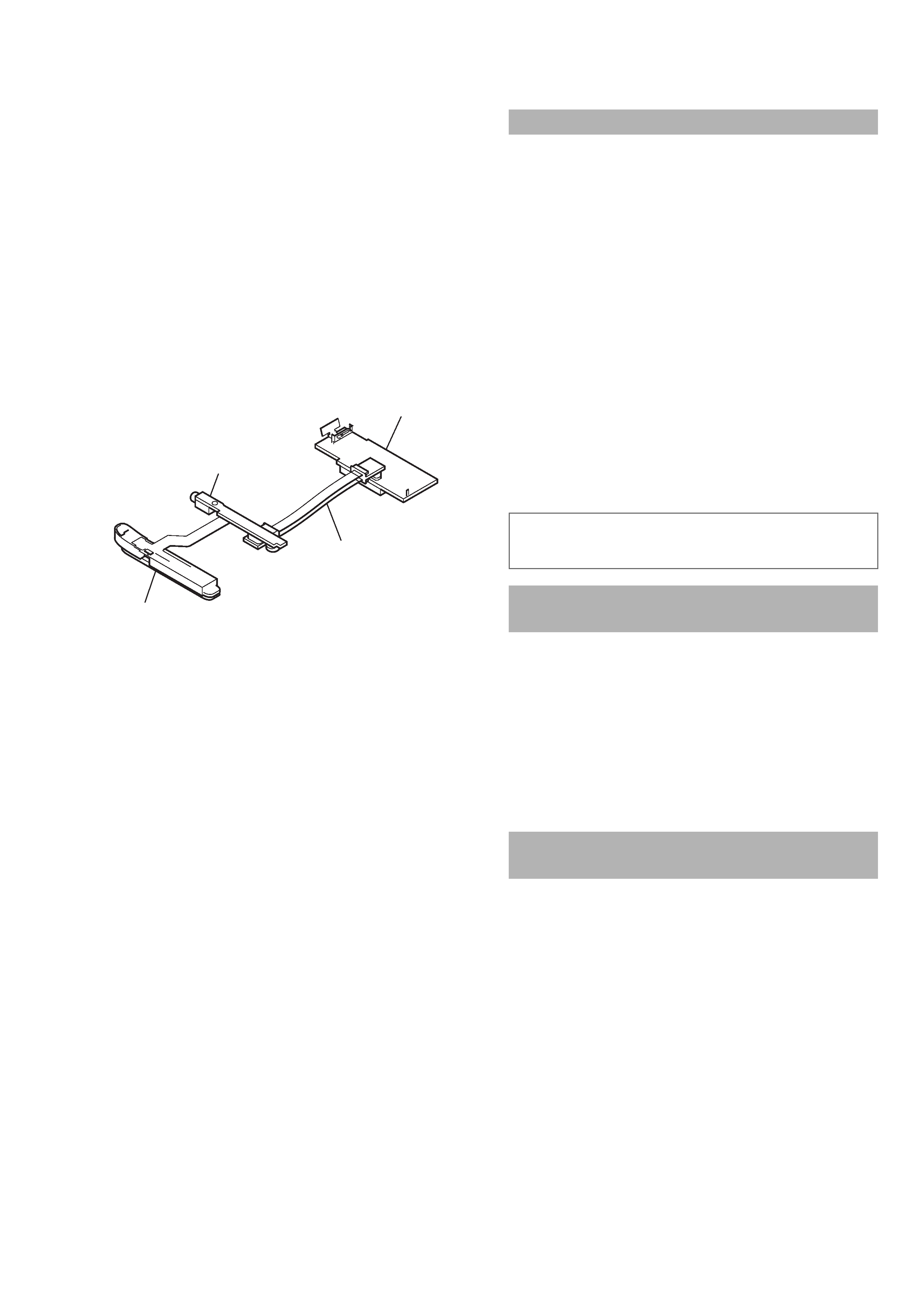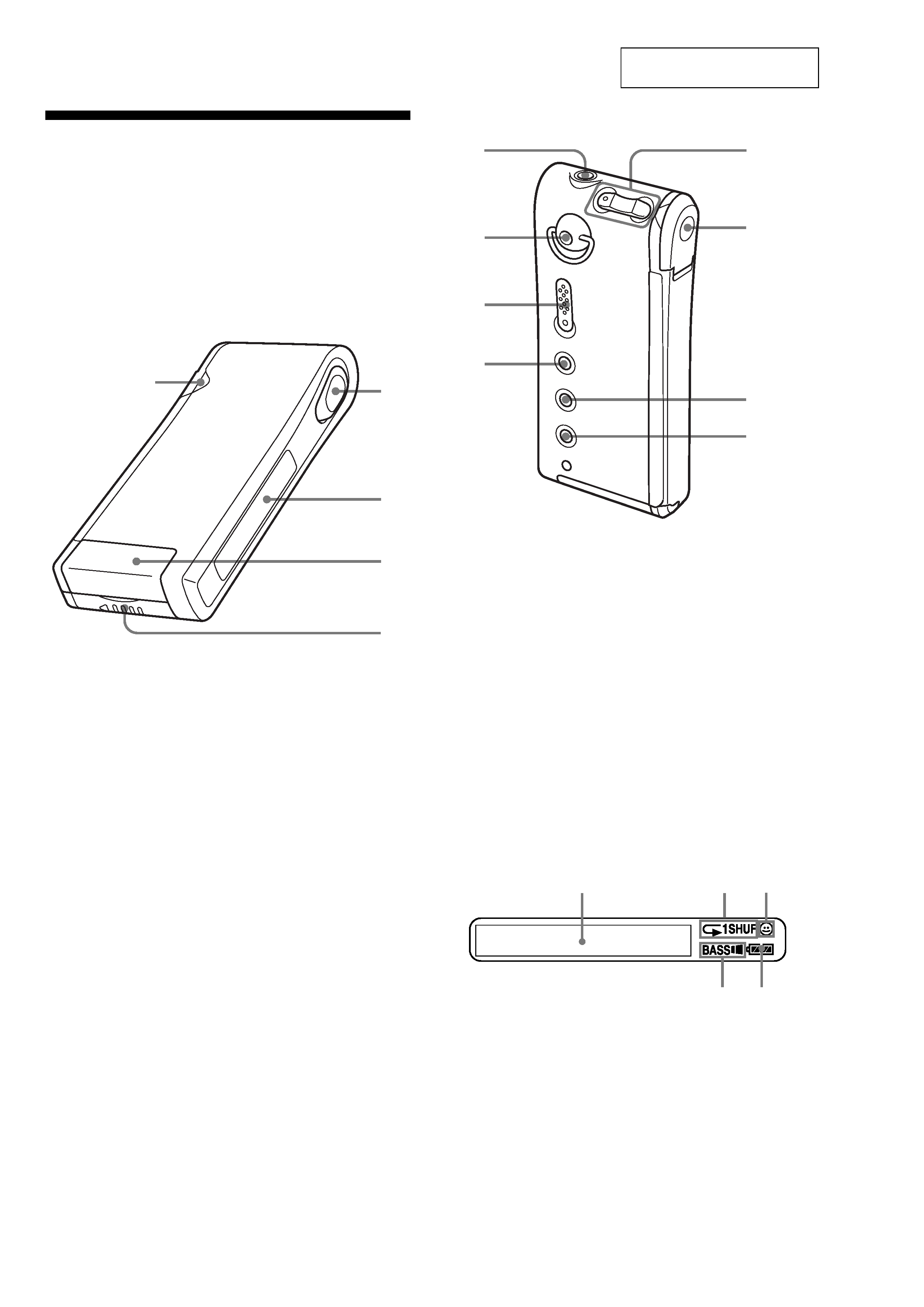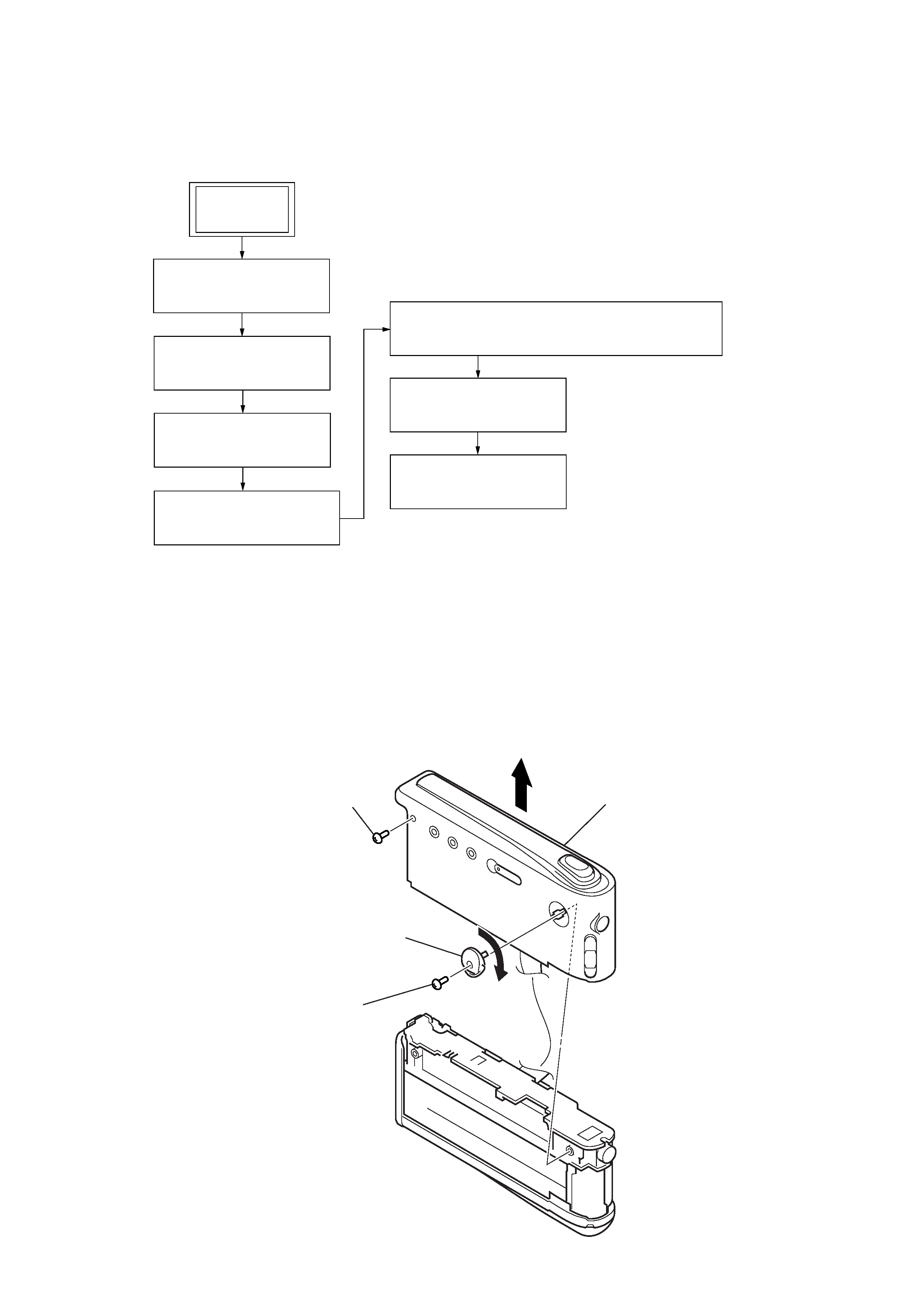
SERVICE MANUAL
PORTABLE MEMORY STICK AUDIO PLAYER
US Model
Canadian Model
AEP Model
UK Model
E Model
Australian Model
SPECIFICATIONS
NW-MS11
Ver 1.0 2002.03
Recording time (when using the
supplied 128MB "MagicGate Memory
Stick")
Approx. 120 min. (132kbps)
Approx. 160 min. (105kbps)
Approx. 240 min. (66kbps)
Sampling frequency response
44.1kHz
Recording format
ATRAC3
Frequency response
20 to 20,000 Hz (single signal measurement)
Output
Headphone/earphone: stereo mini-jack
Signal-to-noise ratio (S/N)
More than 80dB (excluding 66 kbps)
Dynamic range
More than 85dB (excluding 66 kbps)
Operating temperature
5°C to 35°C (-41°F to 95°F)
Power source
· DC IN 1.2V (gum type, secondary battery
Ni-MH (NH-14WM))
· Power for USB (supplies from the computer
through supplied USB cable)
Battery life
Approx. 10 hours (continuous playback)
Dimensions (approx.)
36
× 81.4 × 14.1 mm (1 7/16 × 3 1/4 × 9/16 inches)
(w/h/d, projecting parts not included)
Mass (approx.)
67g (2.4 oz) (includes "Memory Stick," battery
NH-14WM)
Supplied accessories
128MB "MagicGate Memory Stick" (1)
Rechargeable battery (1)
Battery charger (1)
AC plug adaptor (1) (Except U.S.A., Canada,
Europe, Hong Kong and Australia model)
Earphones (1)
USB cable (1)
"Memory Stick" storage case (1)
Rechargeable battery carrying case (1)
Carrying pouch (1) (Except for U.S.A. and Canada
model)
Carrying case (1) (For U.S.A. and Canada model
only)
Key ring (1) (Except for U.S.A. and Canada model)
CD-ROM (OpenMG Jukebox installation disc) (1)
NW-MS11 Operating Instructions (1)
OpenMG Jukebox Operating Instructions (1)
Design and specifications are subject to change
without notice.
9-873-666-01
Sony Corporation
2002C0500-1
Personal Audio Company
C
2002.03
Published by Sony Engineering Corporation
· OpenMG, "MagicGate", "MagicGate Memory Stick",
"Memory Stick" , Music Clip and their logos are
· WALKMAN is a registered trademark of Sony
· Microsoft, Windows, Windows NT and Windows
Media are trademarks or registered trademarks of
· IBM and PC/AT are registered trademarks of
· Macintosh is a trademark of Apple Computer, Inc. in
· MMX and Pentium are trademarks or registered
· CD-related data through the Internet from the
· CDDB-Enabled(TM), CDDB(TM), CDDB 2(TM) and
Disc Recognition Service and DRS are service marks
· All other trademarks are trademarks of their respective
trademarks of Sony Corporation.
Corporation.
Microsoft Corporation in the United States and/or other
countries.
International Business Machines Corporation.
the United States and/or other countries.
trademarks of Intel Corporation.
CDDB(TM) Music CD Database, Copyright 1999,
2000 CDDB, Inc. CDDB Client Software, Copyright
1999, 2000 CDDB, Inc.
the CDDB Logo are trademarks of CDDB, Inc.
of CDDB, Inc.
owners.

2
NW-MS11
TABLE OF CONTENTS
1.
SERVICING NOTES ............................................... 3
2.
GENERAL ................................................................... 4
3.
DISASSEMBLY
3-1. Disassembly Flow ...........................................................
5
3-2. Case Block Assy ..............................................................
5
3-3. Case .................................................................................
6
3-4. Guide (LED) ....................................................................
7
3-5. Chassis (Main) Assy .......................................................
7
3-6. Console Unit, SUB Board And MAIN Board ................
8
3-7. Console Assy ...................................................................
8
3-8. Console Board .................................................................
9
4.
TEST MODE .............................................................. 10
5.
DIAGRAMS
5-1. Block Diagram MAIN Section .................................. 15
5-2. Block Diagram
DISPLAY/POWER SUPPLY Section ....................... 16
5-3. Note for Printed Wirinig Boards and
Schematic Diagrams ....................................................... 17
5-4. Schematic Diagram MAIN Section (1/4) .................. 19
5-5. Schematic Diagram MAIN Section (2/4) .................. 20
5-6. Schematic Diagram MAIN Section (3/4) .................. 21
5-7. Schematic Diagram MAIN Section (4/4) .................. 22
5-8. Printed Wiring Boards MAIN Section ...................... 23
5-9. Printed Wiring Board SUB Section ........................... 24
5-10. Schematic Diagram SUB Section (1/2) ..................... 25
5-11. Schematic Diagram SUB Section (2/2) ..................... 26
5-12. IC Pin Function Description ........................................... 31
6.
EXPLODED VIEWS
6-1. Case Section .................................................................... 39
6-2. Cover Section .................................................................. 40
6-2. MAIN Board Section ...................................................... 41
7.
ELECTRICAL PARTS LIST ............................... 42
SAFETY-RELATED COMPONENT WARNING!!
COMPONENTS IDENTIFIED BY MARK 0 OR DOTTED
LINE WITH MARK 0 ON THE SCHEMATIC DIAGRAMS
AND IN THE PARTS LIST ARE CRITICAL TO SAFE
OPERATION. REPLACE THESE COMPONENTS WITH
SONY PARTS WHOSE PART NUMBERS APPEAR AS
SHOWN IN THIS MANUAL OR IN SUPPLEMENTS PUB-
LISHED BY SONY.
Notes on chip component replacement
·Never reuse a disconnected chip component.
· Notice that the minus side of a tantalum capacitor may be dam-
aged by heat.
Flexible Circuit Board Repairing
·Keep the temperature of the soldering iron around 270 °C dur-
ing repairing.
· Do not touch the soldering iron on the same conductor of the
circuit board (within 3 times).
· Be careful not to apply force on the conductor when soldering
or unsoldering.
UNLEADED SOLDER
Boards requiring use of unleaded solder are printed with the lead-
free mark (LF) indicating the solder contains no lead.
(Caution: Some printed circuit boards may not come printed with
the lead free mark due to their particular size)
: LEAD FREE MARK
Unleaded solder has the following characteristics.
· Unleaded solder melts at a temperature about 40 °C higher than
ordinary solder.
Ordinary soldering irons can be used but the iron tip has to be
applied to the solder joint for a slightly longer time.
Soldering irons using a temperature regulator should be set to
about 350 °C .
Caution: The printed pattern (copper foil) may peel away if the
heated tip is applied for too long, so be careful!
· Strong viscosity
Unleaded solder is more viscous (sticky, less prone to flow) than
ordinary solder so use caution not to let solder bridges occur
such as on IC pins, etc.
· Usable with ordinary solder
It is best to use only unleaded solder but unleaded solder may
also be added to ordinary solder.
NOTES:
· The recorded music is limited to private use only. Use of the music beyond this limit requires permission
of the copyright holders.
· Sony is not responsible for music files that are not saved on your computer due to unsuccessful recording
from CD or music downloading.
Other features
·Compact size, light weight.
· Skip-proof: you can enjoy uninterrupted enjoyment of music during physical activities such as
jogging or commuting.
·Approximately 10 hours of continuous playback with a rechargeable nickel hydride battery.
·Recordable time: up to 120 min., 160 min., 240 min.**, on the supplied 128MB "MagicGate
Memory Stick."
·Backlight LCD screen: song titles and artist names can be displayed.
·High speed data transfer using the supplied USB cable.
·OpenMG Jukebox software enables you to record compact discs using the ATRAC3 format
(high sound quality, high compression) to the hard drive.
* OpenMG and MagicGate technology conforms to the SDMI (Secure Digital Music Initiative) specifications
and allows you to enjoy digital music while maintaining the copyrights of its holders.
**Differs according to the bit rate when recording. In this case, the figures for the recordable time are when
recording on a 128MB "MagicGate Memory Stick" at 132kbps, 105kbps, and 66kbps.
ATTENTION AU COMPOSANT AYANT RAPPORT
À LA SÉCURITÉ!
LES COMPOSANTS IDENTIFIÉS PAR UNE MARQUE 0
SUR LES DIAGRAMMES SCHÉMATIQUES ET LA LISTE
DES PIÈCES SONT CRITIQUES POUR LA SÉCURITÉ
DE FONCTIONNEMENT. NE REMPLACER CES COM-
POSANTS QUE PAR DES PIÈCES SONY DONT LES
NUMÉROS SONT DONNÉS DANS CE MANUEL OU
DANS LES SUPPLÉMENTS PUBLIÉS PAR SONY.

3
NW-MS11
·NOTE FOR REPLACING THE EEPROM (IC6002)
In case of replacing the EEPROM (IC6002) when repairing this
set, it is necessary to write the setting for destination.
When replacing the EEPROM (IC6002), write the setting for
destination, referring to "4. TEST MODE, Items to Check in
the Test Mode, 3-2. Writing Destination".
·Replacement of MBM29LV400BC-90PBT (IC5000),
uPD442002FQ-BB70X-BC1 (IC5600), CXD9534BGG
(IC7001) and CXD1859GA (IC8000) used in this set requires a
special tool.
·To check the operation when the MAIN board and SUB board
are removed, check it after connecting CN100 on the MAIN
board and CN200 on the SUB board with the servicing jig (relay
board between the MAIN board and SUB board) as shown below.
SECTION 1
SERVICING NOTES
MAIN board
console unit
SUB board
servicing jig
(MAIN/SUB relay board)
System requirements
· IBM PC/AT or Compatible
CPU: MMXTM Pentium
®
233 MHz or higher
Hard disk drive space: 60 MB or more
RAM: 64 MB or higher
CD-ROM drive
Sound Board
USB port
· Operating System: Windows® 98/Windows® 98 Second Edition/Windows®
2000 Professional/Windows® Me/Windows XP Home Edition/
The following
Other versions of Windows® 95, Windows® NT, Windows 2000
Upgraded from Windows® 3.1/95 to Windows® 98 (or Windows® 98
Windows® Me) or from Windows® Me/Windows® 2000
Dual boot with Windows® 2000 (or Windows XP) and Windows®
98 (or Windows® 98 Second Edition/Windows® Me)
· Display: High (16bit) Color or more (800
× 480 dot or more)
· Internet access: for Web registration and EMD services
Note
We do not assure trouble-free operation for all computers satisfying the system
Note
For the protection of copyrights when you use the computer with an optical
digital output connector, it may be disabled during playback with this software.
Notes on using OpenMG Jukebox with
Windows 2000/Windows XP
OpenMG Jukebox software users with Windows 2000/Windows XP
models should be aware of the following:
· Only Administrators are allowed to install and uninstall the OpenMG
· To use the application, log on with the user name of "Administrator" or
· Do not remove or insert the CD-ROM drive connected via a PC card
while OpenMG Jukebox is running.
· Only Windows 2000 Professional is supported. If you use Windows XP,
both Professional Edition and Home Edition are supported.
· Only manufacturer installed NTFS format is supported.
Notes on the "System Restore" function
with Windows XP/ Windows Me
If Windows XP or Windows Millennium Edition is installed in your
computer, and you perform the "System Restore" function of the
Windows "System Tools," the songs managed by OpenMG Jukebox may
Therefore, before executing "System Restore," back up the songs using
OpenMG Jukebox Backup Tool first.
Then, after the "System Restore" function is finished, restore the songs
using OpenMG Jukebox Backup Tool to ensure the integrity and
For more information about backup, refer to the online Help for OpenMG
Note
When songs become unplayable by executing "System Restore," an error dialog box
may be displayed. In this case, follow the displayed messages.
Windows XP Professional(manufacturer installed)
environments are not supported.
(e.g., Server, etc.)
Second Edition/
Professional to Windows XP.
requirements.
Jukebox software.
"Power User".
become corrupted and rendered unplayable.
reliability of song playback.
Jukebox.

4
NW-MS11
SECTION 2
GENERAL
This section is extracted from
instruction manual.
Looking at the
controls
Network Walkman
(front)
1 Access lamp (page 9)
2 Seesaw key (page 11-14, 16-22)
3 Display (page 12, 15)
4 Memory Stick slot (page 9, 11)
5 Battery compartment (page 8)
(rear)
6 i (Headphones/earphones) jack (page 11)
7 Hole for attaching the key ring or strap
(The strap is not supplied)
8 HOLD switch (page 16)
9 MEGA BASS/AVLS button (page 14)
0 VOLUME +/ buttons (page 11, 16)
qa Dedicated USB jack (page 9)
qs MENU button (page 13, 16-22)
qd DISPLAY button (page 12, 15)
Display
1 Text/graphic information display
(page 15)
2 Playback mode indication (page 13)
3 AVLS indication (page 14)
4 MEGA BASS indication (page 14)
5 Battery remain indication (page 8)
2
1
3
4
5
6
q;
qa
qs
qd
7
8
9
12
3
45
2 Playback mode indication (page 13)
3 AVLS indication (page 14)
4 MEGA BASS indication (page 14)
5 Battery remain indication (page 8)

NW-MS11
5
· This set can be disassembled in the order shown below.
3-1.
DISASSEMBLY FLOW
SECTION 3
DISASSEMBLY
Note: Follow the disassembly procedure in the numerical order given.
3-2.
CASE BLOCK ASSY
3-2. CASE BLOCK ASSY
(Page 5)
3-3. CASE
(Page 6)
3-6. CONSOLE UNIT, SUB BOARD AND MAIN BOARD
(Page 8)
3-7. CONSOLE ASSY
(Page 8)
3-8. CONSOLE BOARD
(Page 9)
3-5. CHASSIS (MAIN) ASSY
(Page 7)
SET
3-4. GUIDE (LED)
(Page 7)
1
tapping screw
(M1.4
× 3.5)
3
Remove the strap shaft assy rotating
in the direction of arrow A.
2
tapping screw
(M1.4
× 3.5)
4
case block assy
A
